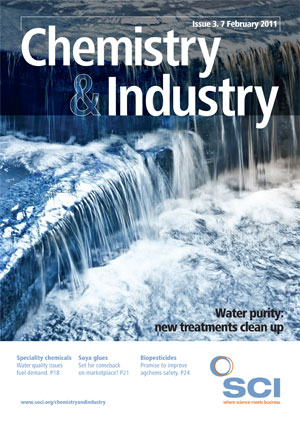Despite the economic downturn, growth in the global water treatment market, while lower than in pre-recession years, remains strong. Demand for both municipal and industrial water is increasing at the same time that access to clean water is decreasing.
The water treatment market will grow at an annual rate of 5.7% through 2013, reaching a value of $58.7bn, according to market research firm The Freedonia Group. While chemicals and filtration equipment will account for over 60% of demand, the greatest growth is anticipated for disinfection equipment, membrane systems and evaporators (Table 1). Demand for membranes and evaporators is expected to grow due to increased use of desalination in many parts of the world. Membranes are seeing increased industrial applications as advances have addressed fouling issues and expanded their ability to remove a wider range of contaminants.

In many markets, there is a trend away from conventional chemical treatments. ‘In the US, we have seen drinking water treatment facilities looking to minimise chlorine use. In industry, we are finding that the motivation to adopt such greener technologies is the need to meet environmental standards and/or the potential for improving process economics,’ notes Susan Hanft, a market analyst with consulting firm BCC Research. She adds that advanced non-chemical processes, such as membranes and filters, also enable the recovery and reuse of valuable raw materials as well as ‘used’ process water. The ability to recycle these products saves industry money in terms of both water and raw materials purchases.

Richard Bendure, group vice president, global water and process marketing and business development for Nalco, notes that ‘industry and governments are increasingly looking at non-chemical and so-called green treatment programmes, water reuse and reclamation, water conservation, energy conservation and enhancements to existing infrastructure. This interest is driving the development of new, integrated offerings that involve chemical, equipment and service components that combine to provide the optimal sustainable solution, which must be balanced against customers’ needs in the areas of capacity, availability, efficiency, etc.’
Advances in technology are also leading to the adoption of greener water treatment systems. Price drops in capital and operating costs, the introduction of packaged treatment systems and continuing improvements in product performance – better targeted removal of contaminants, higher flow rates, enhanced energy efficiency – are some recent broad developments that are making nonchemical treatment methods more attractive, according to Hanft.
A notable area of research involves emerging contaminants (ECs), especially endocrine-disrupting chemicals (EDCs). Most sewage treatment facilities currently use technologies that do not remove these compounds; therefore they may become an issue for industrial plants discharging to publicly owned wastewater treatment plants. Hanft points to ozone generation and advanced oxidation processes (AOPs) as potentially effective solutions.
Improved monitoring systems are also having an impact. ‘Industry needs to optimise performance for continually changing operating conditions. Combining chemical and non-chemical treatments with effective monitoring systems makes it possible to manage cost and performance so that the treatment solution is a proactive one rather than a reactive one,’ observes Nancy White, general manager of product management water services for GE Power & Water. The result is the ability to achieve higher cycles of concentration through optimised scale, corrosion and microbiological control.
Non-chemical methods attracting significant attention include reverse osmosis membranes, ultrasonic systems, UV treatment and ozone generation. The latter three are designed for microbiological control, which can be an expensive proposition using chemical biocides. ‘Non-chemical methods can be very attractive systems where they are applicable and effective, because often the overall cost of control can be reduced,’ notes William F. Harfst, ceo of consulting firm Harfst and Associates.
Ashland has seen a dramatic increase in interest in its Sonoxide ultrasonic water treatment system in the last few years. In this system, air is introduced into a sidestream of cooling water that is continuously recirculated through an ultrasonic chamber along with air induced mirco-bubbles. The bacteria in the water are exposed to low-power (10 W/cm2), high frequency (1.5-2.0 MHz) ultrasonic energy in a series of chambers, which causes cell damage that leads ultimately to death of the bacteria and the reduction and often clean-up and elimination of biofilms that can harbour other pathogens, according to Hamidi. ‘Using Sonoxide not only can eliminate the need for chemical biocide treatment, it also can lead to reduction in water consumption and increased cycles of concentration and therefore reduced cooling water consumption, particularly where Sonoxide is displacing bleach application,’ she remarks.
GE offers a broad range of non-chemical control methods including membrane – reverse osmosis (RO), hollow fibre, electrolytic – thermal evaporation and advanced filtration technologies for its industrial customers.
Other newer technologies are attracting some interest as well, comments Harfst. Halogenation and electrochemical systems are two examples. MIOX has developed a system that generates hypochlorite or mixed oxidants – chlorine and other chlor-oxygen compounds – electrolytically using salt, water and electricity that, according to the company, has excellent efficacy including biofilm elimination.
Capacitive deionisation (CDI) technology from Primary Water is another electrolytic water purification method that removes dissolved salts and impurities as negative and positive ions by attracting them to opposite polarity electrodes. The Plimmer system requires no chemical treatment, consumes less energy than RO membrane systems and is also less susceptible to biofouling, according to the company.
Researchers at Stanford University, US, meanwhile, recently announced the development of a cotton filter infused with microscopic silver nanowires and carbon nanotubes. When a minor amount of electricity is passed through the filter, it can remove 98% of E. coli in a water sample in one pass and is easily scalable to rapidly and effectively treat industrial quantities of water, according to Yi Cui, associate professor at Stanford (C&I, 2010, 23, 13).
Environment-responsive membranes from NanoBrane incorporate nanoparticles that respond to changes in water quality, light, electric and magnetic fields and pressure, with the pore size and structure adjusting to modify the affinity of the membrane for different substances, making it easier to clean and therefore more efficient.
Nanotech-based water treatments will likely be important in the near future, according to Hanft. Promising nanotechnologies for water treatment include nano-enabled membranes, carbon nanotubes, nanofibers and a range of nanoparticles. ‘Many researchers believe that nanotechnologies will enable significant changes in the affordability, effectiveness, efficiency, and robustness of water treatment. Proponents of this supposition believe that using nanomaterials will allow manufacturing that is less polluting than traditional methods and will require less labour, capital, land and energy.’
Advances are also being made in chemical water treatment solutions and chemical treatment combined with highly advanced monitoring systems. ‘While the industry has come very far in the last three decades, there is still room to improve the environmental profile of water treatment chemicals,’ states Paul Turgeon, president and ceo of BWA Water Additives. ‘New regulations are coming in the next three to five years that will require better environmental fate performance. We are introducing next generation scale control chemicals and a new biocide in early 2011 that will help our customers be prepared in advance,’ he notes.
Developing these more environmentally friendly chemistries is a real challenge, though, because they must also perform under more extreme conditions. ‘To allow for increased recycling and reuse of water, treatment chemicals must be more robust, but more robust chemistry has in the past typically been less environmentally friendly,’ Turgeon says. Industrial plants are generally running at higher temperatures and flow rates, too, and there is also a concern about treating difficult toxins such as the pathogens that cause Legionnaire’s disease.
BWA’s newest maleic-based polymeric scale control chemicals have similar pH and handling profiles but break down more readily in the environment and offer improved performance compared with current products, according to Turgeon. The company’s new biocide, which was approved by the EPA in November 2010, is a next generation quaternary phosphonium salt based on tributyl tetradecyl phosphonium chloride (TTPC) that provides broad-spectrum protection, prevents slime formation and is more efficient than currently available products.
‘For Ashland, we continue to further develop our high performing chemistry platforms to help customers comply with regulations that are increasingly stringent with respect to phosphorus and metals,’ states Hamidi. The company currently offers its EnviroPlus line of corrosion and scale inhibitors, biodispersants and biocides based on natural, biodegradable and renewable ingredients, such as its biodegradable carboxylic antiscalant polymer. These products do not contain heavy metals, have a low phosphorus content and eliminate the need for acid feed for pH control. Importantly, they also allow for increased cycles of concentration and therefore reduced water consumption. ‘Even with this greener chemistry, Ashland continues to develop next generation products to meet the changing needs of industrial customers and achieve that ultimate goal of treatment solutions with zero phosphorus and zero metals content,’ Hamidi says.
In addition to being greener and high performing, new chemistries must also be able to withstand varying operational conditions and be forgiving when upsets occur, according to White. ‘Improved polymer technology is making it possible not only to manage tough-to-treat systems, but to respond to constantly changing water quality and operating conditions, which is allowing for higher cycles of concentration and a reduction in the overall environmental footprint of the plant.’
For example, GE’s new GenGard 8000 chemistry includes a stress tolerant polymer (STP) that can continue to provide scale and corrosion control even during upsets and can also be used in conjunction with the most cost-effective biocides, according to White. In addition, it is designed to work with GE’s new TrueSense monitoring and control system for cooling water that helps users manage costs and minimise water consumption and discharge.
Likewise, Ashland has launched the OnGuard 2-plus analyser, a combined chemistry and equipment system built upon its OnGuard monitoring and control platform. The OnGuard 2-plus analyser is the only commercial system capable of real time measurement of both inorganic and biological fouling, according to Hamidi. ‘Measuring both components in real time allows for proper adjustment of specific chemistries required at that moment in time, and is more sophisticated than traditional monitoring and control systems that make dosing adjustments based on a set point irrespective of fouling type and thickness,’ she explains.
For Nalco, the focus is on developing new and improved chemical and biological solutions combined with smarter management systems. ‘The smarter application component is very important because so many of the systems we’re treating are dynamic, with various aspects of them changing almost continually,’ Bendure explains. ‘Better control of treatment improves heat transfer, reduces the need for make-up water and increases efficiency, too.’
Its 3D TRASAR automation technology fingerprints chemistries using fluorescent tracers to better monitor actual system conditions in real time, taking measurements every six seconds and making the appropriate adjustments in the treatment programme immediately. The company is expanding the technology beyond cooling water to boiler water, membrane treatment and wastewater systems.
Nalco is also developing next generation antiscalants, corrosion inhibitors, waste reduction and process chemistries, and combining them with improved monitoring and control to boost the performance and cost-effectiveness of these integrated solutions that incorporate equipment, chemistry and automation, according to Bendure.
‘There are growing numbers of applications that involve extreme operation conditions – high temperatures or harsh chemicals – where existing technologies are challenged,’ Hanft comments. ‘Furthermore, there are still unmet needs related to improving energy efficiency, lowering capital and operating costs, offering better selectivity for removing target species and providing higher flow rates.’ Both chemical and non-chemical treatment solutions will be important in helping industries effectively and efficiently use limited water resources in the future.
Cynthia Challener is a freelance science writer based in Hardwick, Vermont, US





